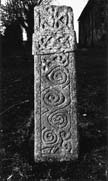Select a site alphabetically from the choices shown in the box below. Alternatively, browse sculptural examples using the Forward/Back buttons.
Chapters for this volume, along with copies of original in-text images, are available here.
Object type: Part of cross-shaft [1]
Measurements: H.>133 cm (> 52.4 in) W.40 > 30 cm (15.7 >11.8 in) D. 21 > 14.5 cm (8.3 > 5.7 in)
Stone type: Yellowish grey (10YR 8/2–3), very shelly, planar bedded oolitic limestone with ooliths from 0.3 to 0.8mm in diameter closely packed with shell fragments and gastropod remains, in a crystalline calcite cement. Barnack Rag type, Upper Lincolnshire Limestone, Inferior Oolite Group
Plate numbers in printed volume: Ills. 124–7
Corpus volume reference: Vol 5 p. 139-140
(There may be more views or larger images available for this item. Click on the thumbnail image to view.)
The shaft from a small standing cross which is missing only its head. It is decorated on all four faces with interlace and other designs in low relief. The shaft has a projecting collar towards the head end. The angles of both the collar and of the shaft itself are undecorated and of rectangular section.
A (broad): In the upper panel, two vertical runs of three-strand plait, with paired strands joined below. On the collar, a horizontal run of three-strand plait with two loose ends in opposite corners. In the lower panel, a debased vine-scroll of slightly rounded section. The stem arises out of an indeterminate rectangular panel at the base, the whorls of the stem itself are very inaccurately cut and are without flowers until it reaches the top, where a series of intersecting lines, reminiscent of interlace, form a stylised 'bud'.
B (narrow): In the upper panel, a vertical run of three-strand plait. On the collar, two closed-circuit oval loops (motif iii, Fig. 10). In the lower panel, a four-strand plait of rectangular section with cross-joined terminals.
C (broad): In the upper panel, two addorsed simple pattern E knots, with paired strands joined below. On the collar, an oblong closed-circuit motif crossed by two diagonal strands with bar terminals (a design based on the free ring but with all of the corners squared off to fit the motif into the rectangular field). The lower panel is unusual. It is an accurately cut but completely undecorated field, almost as though it has been prepared for a design in a different material.
D (narrow): In the upper panel, a 'Greek key' pattern. On the collar, two closed-circuit oval loops. In the lower panel, a four-strand plait of rectangular section with cross-joined terminals.
This shaft has most of the characteristics associated with the South Kesteven shaft group (Chapter V). It is of the characteristic section (i.e. it is about twice as broad as it is deep); it is made of the characteristic light grey shelly Barnack ragstone; it has panels with undecorated rectangular borders and it has a projecting collar. The interlace designs used on Creeton 1 are also typical of the group, i.e. four-strand plaits decorating the narrow faces; a debased vine-scroll (which is very similar in its details to that on Colsterworth 1, Ills. 96–7); and, also like Colsterworth 1, Creeton 1 has an interlace run of simple pattern E (on face C). The collar at Creeton is similar to that surviving on the Elloe Stone, which is also decorated with closed-circuit oval loops on its narrow faces (Ills. 171–2, 176–8). The Elloe Stone also has three-strand plait in the narrow panels above the collar, as at Creeton 1. The Elloe Stone still has its head (an un-perforated ring cross with simple interlace), and we may guess that Creeton 1 originally had a cross-head of similar type. The 'Greek key' pattern on face D, on the other hand, is only found in the county on the grave-cover at Tallington (Ill. 360) and since this, too is a Barnack ragstone product they may have a common source. Within the South Kesteven group Creeton 1, along with Colsterworth 1, is of above average competence and sophistication (when compared, for example, with Stoke Rochford). Furthermore, as far as is known, these two (along with the single example at Peterborough Cathedral) are also the only monuments in this group which carry debased vine-scroll. These features probably indicate that the monuments at Creeton and Colsterworth are not only closely related to each other, but are also quite early examples of the South Kesteven shaft type, suggesting a date in the later tenth century rather than subsequently.



